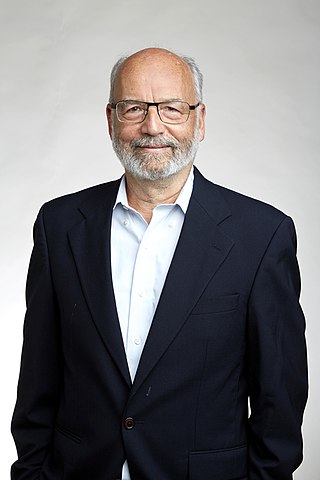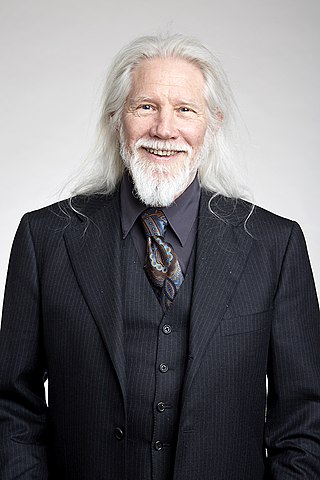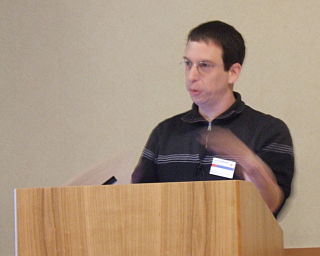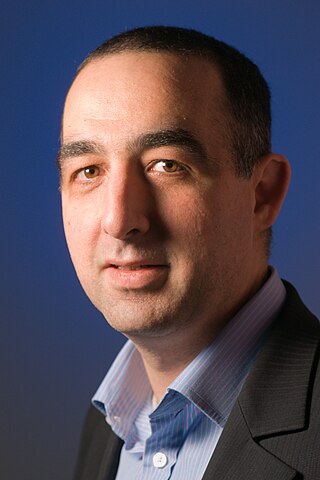
Cryptanalysis refers to the process of analyzing information systems in order to understand hidden aspects of the systems. Cryptanalysis is used to breach cryptographic security systems and gain access to the contents of encrypted messages, even if the cryptographic key is unknown.

The Data Encryption Standard is a symmetric-key algorithm for the encryption of digital data. Although its short key length of 56 bits makes it too insecure for modern applications, it has been highly influential in the advancement of cryptography.

Adi Shamir is an Israeli cryptographer and inventor. He is a co-inventor of the Rivest–Shamir–Adleman (RSA) algorithm, a co-inventor of the Feige–Fiat–Shamir identification scheme, one of the inventors of differential cryptanalysis and has made numerous contributions to the fields of cryptography and computer science.

Vincent Rijmen is a Belgian cryptographer and one of the two designers of the Rijndael, the Advanced Encryption Standard. Rijmen is also the co-designer of the WHIRLPOOL cryptographic hash function, and the block ciphers Anubis, KHAZAD, Square, NOEKEON and SHARK.

Bailey Whitfield 'Whit' Diffie ForMemRS is an American cryptographer and mathematician and one of the pioneers of public-key cryptography along with Martin Hellman and Ralph Merkle. Diffie and Hellman's 1976 paper New Directions in Cryptography introduced a radically new method of distributing cryptographic keys, that helped solve key distribution—a fundamental problem in cryptography. Their technique became known as Diffie–Hellman key exchange. The article stimulated the almost immediate public development of a new class of encryption algorithms, the asymmetric key algorithms.
NESSIE was a European research project funded from 2000 to 2003 to identify secure cryptographic primitives. The project was comparable to the NIST AES process and the Japanese Government-sponsored CRYPTREC project, but with notable differences from both. In particular, there is both overlap and disagreement between the selections and recommendations from NESSIE and CRYPTREC. The NESSIE participants include some of the foremost active cryptographers in the world, as does the CRYPTREC project.
In cryptography, LOKI89 and LOKI91 are symmetric-key block ciphers designed as possible replacements for the Data Encryption Standard (DES). The ciphers were developed based on a body of work analysing DES, and are very similar to DES in structure. The LOKI algorithms were named for Loki, the god of mischief in Norse mythology.
In cryptography, the eXtended Sparse Linearization (XSL) attack is a method of cryptanalysis for block ciphers. The attack was first published in 2002 by researchers Nicolas Courtois and Josef Pieprzyk. It has caused some controversy as it was claimed to have the potential to break the Advanced Encryption Standard (AES) cipher, also known as Rijndael, faster than an exhaustive search. Since AES is already widely used in commerce and government for the transmission of secret information, finding a technique that can shorten the amount of time it takes to retrieve the secret message without having the key could have wide implications.
Lars Ramkilde Knudsen is a Danish researcher in cryptography, particularly interested in the design and analysis of block ciphers, hash functions and message authentication codes (MACs).

Dan Boneh is an Israeli–American professor in applied cryptography and computer security at Stanford University.
In cryptography, Crab is a block cipher proposed by Burt Kaliski and Matt Robshaw at the first Fast Software Encryption workshop in 1993. Not really intended for use, Crab was developed to demonstrate how ideas from hash functions could be used to create a fast cipher.
In cryptography, CIPHERUNICORN-E is a block cipher created by NEC in 1998. It was among the cryptographic techniques recommended for Japanese government use by CRYPTREC in 2003. However, it has been dropped to "candidate" level by the CRYPTREC revision of 2013.
In cryptography, CIPHERUNICORN-A is a block cipher created by NEC in 2000. It was among the cryptographic techniques recommended for Japanese government use by CRYPTREC in 2003. However, it has been dropped to "candidate" level by the CRYPTREC revision of 2013.

David Naccache is a cryptographer, currently a professor at the École normale supérieure and a member of its Computer Laboratory. He was previously a professor at Panthéon-Assas University.
In cryptography, truncated differential cryptanalysis is a generalization of differential cryptanalysis, an attack against block ciphers. Lars Knudsen developed the technique in 1994. Whereas ordinary differential cryptanalysis analyzes the full difference between two texts, the truncated variant considers differences that are only partially determined. That is, the attack makes predictions of only some of the bits instead of the full block. This technique has been applied to SAFER, IDEA, Skipjack, E2, Twofish, Camellia, CRYPTON, and even the stream cipher Salsa20.

Founded in 1990, the Information Security Group (ISG) is an academic department focusing on Information and Cyber Security within the Engineering, Physical Sciences and Mathematics School (EPMS) at Royal Holloway, University of London. It has around 25 established academic posts, 7 visiting Professors or Fellows and over 90 research students. The Founder Director of the ISG was the late Professor Fred Piper, and the current director is Professor Lizzie Coles-Kemp. Previous directors include Professors Peter Komisarczuk, Keith Martin, Keith Mayes, Chris Mitchell and Peter Wild.

Cryptography, or cryptology, is the practice and study of techniques for secure communication in the presence of adversarial behavior. More generally, cryptography is about constructing and analyzing protocols that prevent third parties or the public from reading private messages. Modern cryptography exists at the intersection of the disciplines of mathematics, computer science, information security, electrical engineering, digital signal processing, physics, and others. Core concepts related to information security are also central to cryptography. Practical applications of cryptography include electronic commerce, chip-based payment cards, digital currencies, computer passwords, and military communications.
PRESENT is a lightweight block cipher, developed by the Orange Labs (France), Ruhr University Bochum (Germany) and the Technical University of Denmark in 2007. PRESENT was designed by Andrey Bogdanov, Lars R. Knudsen, Gregor Leander, Christof Paar, Axel Poschmann, Matthew J. B. Robshaw, Yannick Seurin, and C. Vikkelsoe. The algorithm is notable for its compact size.
Algebraic Eraser (AE) is an anonymous key agreement protocol that allows two parties, each having an AE public–private key pair, to establish a shared secret over an insecure channel. This shared secret may be directly used as a key, or to derive another key that can then be used to encrypt subsequent communications using a symmetric key cipher. Algebraic Eraser was developed by Iris Anshel, Michael Anshel, Dorian Goldfeld and Stephane Lemieux. SecureRF owns patents covering the protocol and unsuccessfully attempted to standardize the protocol as part of ISO/IEC 29167-20, a standard for securing radio-frequency identification devices and wireless sensor networks.
Anne Canteaut is a French researcher in cryptography, working at the French Institute for Research in Computer Science and Automation (INRIA) in Paris. She studies the design and cryptanalysis of symmetric-key algorithms and S-boxes.








